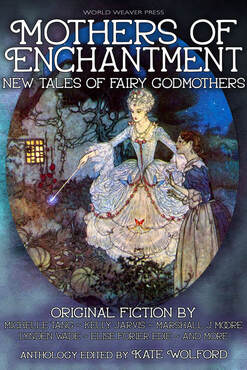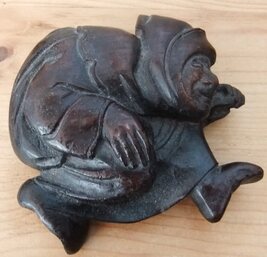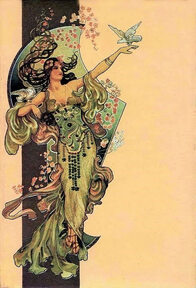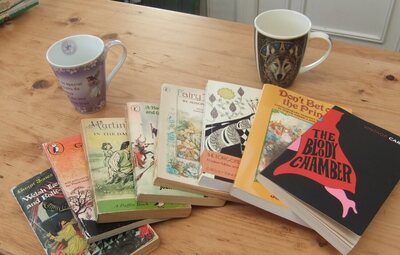 Guest Blog by Lynden Wade The fairy godmother as a kind and powerful old woman doesn't feature in many of the classic fairytales that are currently canon. Yet she certainly captured the imagination of writers of the nineteenth century, who took the wonder and beauty of the old stories and wove new tales of love and laughter. Here are three examples I love, in ascending order for the role the godmother plays. At the end of the post are details of where you can read them.  The Wonderful Rose, by Netta Syrett The main character in this story is a prince who is discontent with his rather privileged life. His fairy godmother has clearly been spoiling him, as she's brought him many presents over the years, none of which has helped him much, and she half realises this: "Hoity-toity!" exclaimed the old lady; for she had ancient forms of speech. "And so, young man, you are not happy, I hear? What are princes coming to, I should like to know?" Her irritation with the younger generation is fun to read, but she isn't a good deal of use to him. She does give him another gift, that of understanding the language of animals and flowers, and this is crucial later for his growth into a wiser, less selfish young man. But the one whose wisdom sends him on the journey that both helps him grow and leads him to his heart's desire is not the fairy godmother at all but the Wise Woman, who lives in a cave in the heart of the forest. It's tempting to argue that these two women are manifestations of the same goddess, but I doubt if that was Syrett's intention. The fairy godmother, judging from her sniffy response to the prince, where she simply puts into words the prince's father's doubts about the boy, is firmly in the royal court, and it might be that she didn't actually anticipate how life-changing her most recent gift would be. It almost certainly wouldn't have brought him his heart's desire on its own, because he needed to leave all the comfort behind and take a hard journey to win that. Read this tale for the frustrated conversations between the members of the older generation, then love it for its wisdom, as the prince makes an astonishing discovery at the end. The Magic Wishbone, by Charles Dickens Dickens has good fun with fairytale tropes here. The royal family in this story is not rich at all; the king works like a clerk and struggles to make ends meet with his seventeen children. The good fairy Grandmarina wears shot silk and smells of dried lavender. She gives a magic wishbone to the oldest girl, Alice, who holds onto it despite various small family disasters, until it comes to the right moment for making a wish that solves all their problems. Grandmarina appears at the end to remind the king that she was right in entrusting the bone to his daughter, not him. Then she whisks Alice off to a marriage which I hope is simply a ceremony at this point, as earlier clues suggest she is seven, though her prince seems the same age. Read it for the fun way in which the fairy godmother puts the king down. It was especially designed, I'm sure, to delight Victorian children who were constantly told to be good and quiet, but we can all enjoy the adventures of this harassed but ultimately delightful family.  A Toy Princess, by Mary de Morgan In a way, this fairytale is quite grim compared to the ones we've looked at so far, not for nastiness like red-hot shoes or the cutting-off of toes (Snow White and Cinderella in Grimm) but for the forbidding atmosphere in the court in which the young Princess Ursula grows up. But that's the whole point: she's a fish out of water and very unhappy. Luckily, her mother's godmother is on the lookout, and takes her away to grow up with a fisherman and his wife in a plain, loving household. The real fun here is the godmother Taboret's resourcefulness in replacing the princess with an automaton, which she commissions off a magician after haggling with him. Ursula's father and his court much prefer the automaton to the real princess. When Taboret brings the princess back on coming of age, and reveals the deception, the courtiers are quite shocked, and don't like the real princess at all. Taboret's solution is ingenious and Ursula gets the happy ending she needs. Read this beautiful story not just for the very active, intelligent and clever godmother, whose role is equal to the princess's, but also for the way Taboret demonstrates that the automaton is a sham. And then ponder the theme. De Morgan wrote it to show how Victorian manners repressed the spirit. But we can read it in a wider way today, a tale that shows how tempting it can be for us to manipulate people into fitting in with our idea of right behaviour, rather than accepting them for who they are. Where to Read These Stories The Wonderful Rose, by Netta Syrett It was part of the collection "A Garden of Delights", now sadly out of print. However, it is part of the collection "A Book of Princes" selected by Christopher Sinclair-Stevenson, still available to buy online. The Magic Wishbone, by Charles Dickens Read it online here. https://www.storyberries.com/fairy-tales-the-magic-fishbone-by-charles-dickens/ A Toy Princess, by Mary de Morgan Read it online here. https://www.shortstoryproject.com/stories/a-toy-princess/
0 Comments
Your comment will be posted after it is approved.
Leave a Reply. |
World Weaver PressPublishing fantasy, paranormal, and science fiction. Archives
February 2024
|
- Home
-
Books
-
All Books
>
- Beyond the Glass Slipper
- Bite Somebody
- Bite Somebody Else
- Black Pearl Dreaming
- Cassandra Complex
- Causality Loop
- Clockwork, Curses, and Coal
- Continuum
- Corvidae
- Cursed: Wickedly Fun Stories
- Dream Eater
- Equus
- Fae
- Falling of the Moon
- Far Orbit
- Far Orbit Apogee
- Fractured Days
- Frozen Fairy Tales
- Glass and Gardens: Solarpunk Summers
- Glass and Gardens: Solarpunk Winters
- Grandmother Paradox
- Grimm, Grit, and Gasoline
- Haunted Housewives
- Heir to the Lamp
- He Sees You When He's Creepin': Tales of Krampus
- Into the Moonless Night
- Jack Jetstark's Intergalactic Freakshow
- King of Ash and Bones (ebook)
- Krampusnacht
- Last Dream of Her Mortal Soul
- Meddlers of Moonshine
- Mothers of Enchantment
- Mrs Claus
- Multispecies Cities
- Murder in the Generative Kitchen
- Recognize Fascism
- Scarecrow
- Sirens
- Shards of History
- Shattered Fates
- Skull and Pestle
- Solarpunk (Translation)
- Solarpunk Creatures
- Solomon's Bell
- SonofaWitch!
- Speculative Story Bites
- Trenchcoats, Towers, and Trolls
- Weredog Whisperer
- Wolves and Witches
- Anthologies and Collections
- Novels
- Novellas
- Fairy Tale
- Fantasy
- Romance
- Science Fiction
- Urban/Contemporary Fantasy
- Young Adult SFF
-
All Books
>
- Blog
- About
- Contact
- Press / Publicity
- Newsletter Signup
- Privacy Policy
- Store

 RSS Feed
RSS Feed